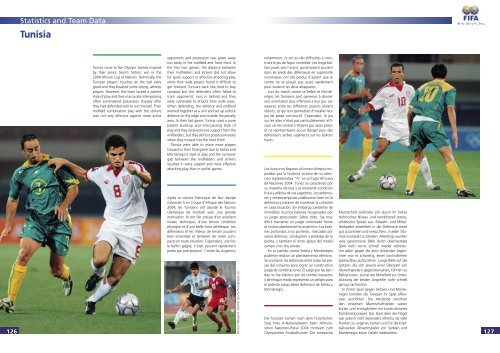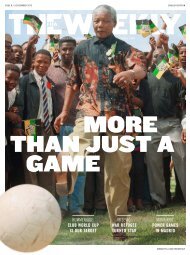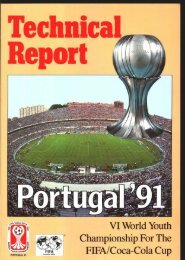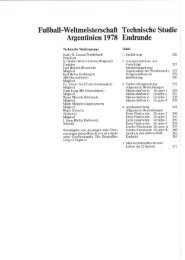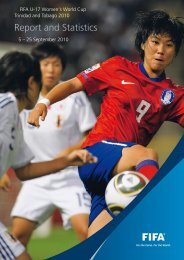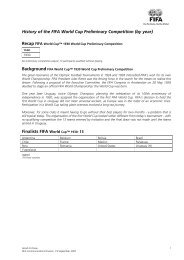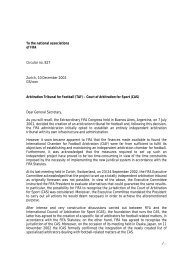Create successful ePaper yourself
Turn your PDF publications into a flip-book with our unique Google optimized e-Paper software.
Statistics and Team Data<br />
Tunisia<br />
Tunisia came to the Olympic Games inspired<br />
by their senior team’s historic win in the<br />
<strong>2004</strong> African Cup of Nations. Technically, the<br />
Tunisian players’ touches on the ball were<br />
good and they boasted some strong, athletic<br />
players. However, the team lacked a patient<br />
style of play and their inaccurate inter-passing<br />
often surrendered possession cheaply after<br />
they had defended well to win the ball. Their<br />
midfield <strong>com</strong>bination play with the strikers<br />
was not very effective against more active<br />
opponents and possession was given away<br />
too easily in the midfield and front third. In<br />
the first two games, the distance between<br />
their midfielders and strikers did not allow<br />
for quick support or effective attacking play,<br />
while their wide players found it difficult to<br />
get forward. Tunisia’s back line tried to stay<br />
<strong>com</strong>pact but the defenders often failed to<br />
track opponents’ runs in behind and they<br />
were vulnerable to attacks from wide areas.<br />
When defending, the defence and midfield<br />
worked together as a unit and set up a block<br />
defence on the edge and outside the penalty<br />
area. In their last game, Tunisia used a more<br />
patient build-up and inter-passing style of<br />
play and they received more support from the<br />
midfielders, but they still lost possession easily<br />
when they moved into the front third.<br />
Tunisia were able to move more players<br />
forward in their final game due to Serbia and<br />
Montenegro’s style of play and the narrower<br />
gap between the midfielders and strikers<br />
resulted in extra support and more effective<br />
attacking play than in earlier games.<br />
Après la victoire historique de leur équipe<br />
nationale A en Coupe d’Afrique des Nations<br />
<strong>2004</strong>, les Tunisiens ont abordé le Tournoi<br />
Olympique de Football avec une grande<br />
motivation. Ils ont fait preuve d’un excellent<br />
niveau technique, d’une bonne condition<br />
physique et d’une belle force athlétique. Les<br />
défenseurs et les milieux de terrain jouaient<br />
bien ensemble et tentaient de rester <strong>com</strong>pacts<br />
en toute situation. Cependant, une fois<br />
le ballon gagné, il était souvent rapidement<br />
perdu par précipitation. Contre les Argentins<br />
Photos: Mexsport, Sideline Sports Photography (2)<br />
notamment, ils ont eu des difficultés à construire<br />
le jeu de façon contrôlée. Les longs ballons<br />
joués vers l’avant, qui arrivaient souvent<br />
dans les pieds des défenseurs en supériorité<br />
numérique, ont été perdus d’autant que le<br />
centre ne se plaçait pas assez rapidement<br />
pour soutenir les deux attaquants.<br />
Lors du match contre la Serbie et Monténégro,<br />
les Tunisiens sont parvenus à donner<br />
une orientation plus offensive à leur jeu. Les<br />
espaces entre les différents joueurs étaient<br />
réduits, ce qui leur permettait d’installer leur<br />
jeu de passe constructif. Cependant, le jeu<br />
sur les ailes n’était pas particulièrement efficace<br />
car les centres n’étaient pas assez précis<br />
et ne représentaient aucun danger pour des<br />
défenseurs serbes supérieurs sur les ballons<br />
hauts.<br />
Los tunecinos llegaron al torneo olímpico inspirados<br />
por la histórica victoria de su selección<br />
representativa “A” en al Copa Africana<br />
de Naciones <strong>2004</strong>. Túnez se caracterizó por<br />
su maestría técnica y la excelente condición<br />
física y atlética de sus jugadores. Los defensores<br />
y centrocampistas colaboraron bien en la<br />
defensiva y trataron de mantener la cohesión<br />
en cada situación. Sin embargo, perdieron de<br />
inmediato muchos balones recuperados por<br />
su juego apresurado. Sobre todo, fue muy<br />
difícil mantener un juego controlado frente<br />
al incisivo planteamiento argentino. Los balones<br />
profundos a los punteros, marcados por<br />
varios defensas, condujeron a pérdidas de la<br />
pelota, y también el lento apoyo del medio<br />
campo a los dos arietes.<br />
En su partido contra Serbia y Montenegro<br />
pudieron realizar un planteamiento ofensivo.<br />
Se acortaron las distancias entre todas las piezas<br />
del conjunto para lograr un constructivo<br />
juego de <strong>com</strong>binaciones. El juego por las bandas<br />
no fue efectivo por los centros inexactos<br />
y de ningún modo representó un peligro para<br />
el potente juego aéreo defensivo de Serbia y<br />
Montenegro.<br />
Die Tunesier kamen nach dem historischen<br />
Sieg ihres A-Nationalteams beim Afrikanischen<br />
Nationen-Pokal <strong>2004</strong> motiviert zum<br />
Olympischen Fussballturnier. Die tunesische<br />
Mannschaft zeichnete sich durch ihr hohes<br />
technisches Niveau und konditionell starke,<br />
athletische Spieler aus. Abwehr- und Mittelfeldspieler<br />
arbeiteten in der Defensive meist<br />
gut zusammen und versuchten, in jeder Situation<br />
kompakt zu bleiben. Allerdings wurden<br />
viele gewonnene Bälle durch überhastetes<br />
Spiel nach vorne schnell wieder verloren.<br />
Vor allem gegen die aktiv störenden Argentinier<br />
war es schwierig, einen kontrollierten<br />
Spielaufbau aufzuziehen. Lange Bälle auf die<br />
Spitzen, die sich jeweils einer Überzahl von<br />
Abwehrspielern gegenübersahen, führten zu<br />
Ballverlusten, zumal das Mittelfeld zur Unterstützung<br />
der beiden Angreifer nicht schnell<br />
genug nachrückte.<br />
In ihrem Spiel gegen Serbien und Montenegro<br />
konnten die Tunesier ihr Spiel offensiver<br />
ausrichten. Die Abstände zwischen<br />
den einzelnen Mannschaftsteilen waren<br />
kürzer und ermöglichten ein konstruktiveres<br />
Kombinationsspiel. Das Spiel über die Flügel<br />
war jedoch nicht besonders effektiv, da viele<br />
Flanken zu ungenau kamen und für die kopfballstarken<br />
Abwehrspieler von Serbien und<br />
Montenegro keine Gefahr bedeuteten.<br />
126 127


